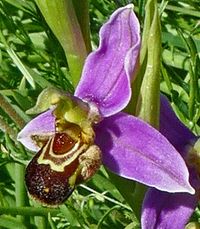Ophrys apifera Huds., Fl. Angl. (Hudson) 340 (1762).
LSID: 647746-1
Synonyms/Synonyme
Arachnites apifer (Huds.) Hoffm., Deutschl. Fl. Bot. 4: 180 (1804).
Ophrys albiflora Spruner ex Boiss., F1. Orient. 5: 79 (1882).
Ophrys aquisgranensis Kaltenb., Verh. Naturhist. Association Preuss. Rheinl. Westphalens 7: 519
(1850).
Ophrys arachnites Mill., Gard. Dict. ed. 8: n.° 7 (1768).
Ophrys asilifera Vayr., Anales Soc. Esp. Hist. Nat. 9: 98 (1880).
Ophrys austriaca Wiesb. ex Dichtl, German Bot. 1: 148 (1883).
Ophrys bicolor O.Nägeli, Ber. Switzerland. Bot. Ges. 23: 64 (1914), nom. illegal.
Ophrys botteronii Chodat, Bull. Trav. Soc. Bot. Genève 5: 187 (1889).
Ophrys chlorantha Hegetschw., Fl. Switzerland: 876 (1840).
Ophrys epeirophora Peter, Flora 66: 10 (1883).
Ophrys friburgensis (Freyhold) O.Nägeli, Ber. Switzerland. Bot. Ges. 21: 178 (1912).
Ophrys immaculata (Bréb.) O.Nägeli, Jahresh. Club father Natural Württemberg 72: 217 (1916).
Ophrys insectifera subsp. apifera (Huds.) Moggr., Nov. Actorum Acad. Caes. Leop.-Carol. Gennan. Nat. Cur. 35 (3): 13 (1869).
Ophrys integra Sacc., Nuovo Giorn. Bot. Ital. 3: 165 (1871).
Ophrys jurana (Ruppert ex Zirnm.) Neuberger, Schulfl. Baden, ed. 7-8: 57 (1925).
Ophrys mangini Tallon, Actes Reserve Zool. Bot. Camargue 24:76 (1941).
Ophrys oestrifera M.Bieb., Fl. Taur.-Caucas. 2: 369 (1808). *
Ophrys picta var. oestrifera (M.Bieb.) Bory & Chaub., Exp. Sci. Morée, Bot .: 62 (1832).
Ophrys purpurea Exchange, Flora 14: 222 (1831).
Ophrys ripaensis Porta, Atti Accad. Rovereto, ser. 3, 11 (2): 7 (1905).
Ophrys rostrata Ten., Index Seminum (NAP, Neapolitano) 1830: 15 (1830).
Ophrys saraepontana Ruppert, Verh. Naturhist. Association Preuss. Rheinl. Westphalens 81: 181
(1924).
Ophrys trollii Hegetschw., Fl. Switzerland: 874 (1840).
Orchis apifera (Huds.) Salisb., Prodr. Stirp. Chap.Allerton: 7 (1796).
Orchis oestrifera (M.Bieb.) M.Bieb., F1. Taur.-Caucas. 3: 605 (1819). *
Orchis pseudoapifera Caldesi, Nuovo Giorn. Bot. Ital. 12: 258 (1880).
* Remark
That Ophrys oestrifera and Orchis oestrifera are synonymous of O. apifera was shown by Hennecke (2021: 120 ff). While everything is pretty straightforward, the St. Petersburg Herbarium is a bigger, unexplained problem).
Polynomials/Polynome
Orchis Serapias secundus, Dodoens (1568).
Testiculus Serapias Dioscoridis, Dodoens (1568).
Testiculus vulpinus sectmdus, Sphegodes, Lobel (1581).
Orchis fucum referens major foliolis suberioribus candidis & purpurascentibus, Bauhin (1623: 83).
Orchis sive testiculus sphegodes hirsuto flore, Bauhin et al. (1651 (2): 767).
Orchis araneam referens, rostro recurvo, Séguier (1754: 246).
Terra typica
Anglis: in pratis et pascuis siccioríbus.
Possible ccnfusion
None. Rectangular, large lip makes a closed impression (side edges of the lip turned down all around), appendages are not or barely visible from the front.
Variability
According to Mayr (19xy), there are no subspecies possible in this huge distribution area, only varieties at most. New varieties are constantly being described, which - based on the work of Baum et al. (2002) - should actually only have the taxonomic status of forma. A classification and assignment of varieties, as made by Baumann (2005), I do not consider to be expedient.
According to the huge range of Ophrys apifera, a lot of taxa have been described, like var. almaracensis, atrofusca, aurita, austriaca, badensis, basiliensis, belgarum, botteronii, brevilabellata, broteroi, cambrensis, clılorantha, cordatitepala, curviflora, filitepala, flavescens, friburgensis, fulvofusca, immaculata, jenensis, jurana, laetitiae, muteliae, patinata, purpurata, renatae, saraepontana, speciosa, subterrostrunca, tilaventina, trollii, urbinensis (list may be not complete).
Flowering phenology
Fruit set
72-89% (Baumann in Sebald et al. 1998: 419).
Pollinator insects
Claessens & Kleynen (2002) showed in their study that the wind is the decisive factor in the pollination process. According to their information, insects seem to play no role at all. This statement is particularly interesting with regard to the many hybrids, of which Weyland (2017: 108) assumes „that humans helped with the creation“. According to him, there should be no documented evidence of pollinator visits with pollen removal and pollination for Ophrys apifera, although visiting insects are mentioned in the literature, see also the note from Godfery (l928; fig. 110/1):
Eucera spec. Meyer (1964)
Eucera nigrescens Baumann et al. (2006)
Microdon spec. Gämperle (2017)
Tetralonia lucasi Meyer (1964)
Altitude distribution
General distribution
